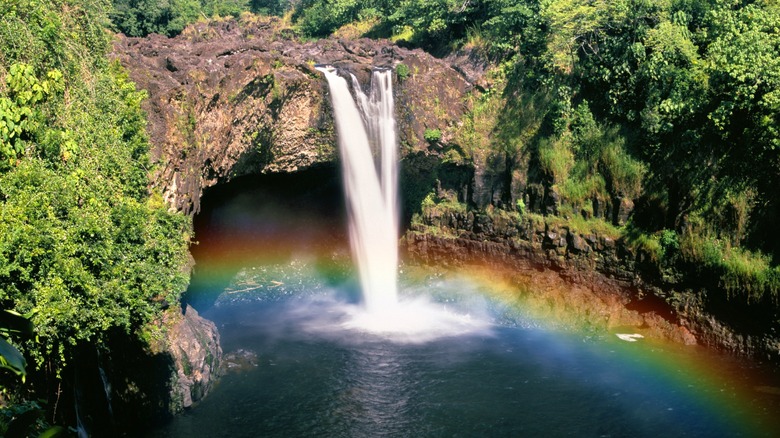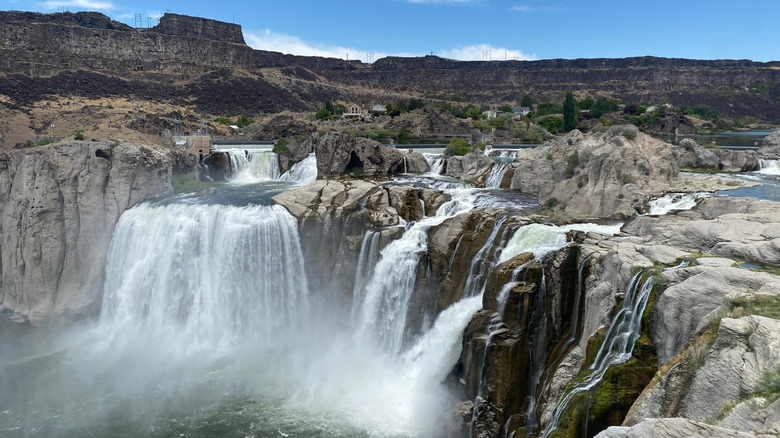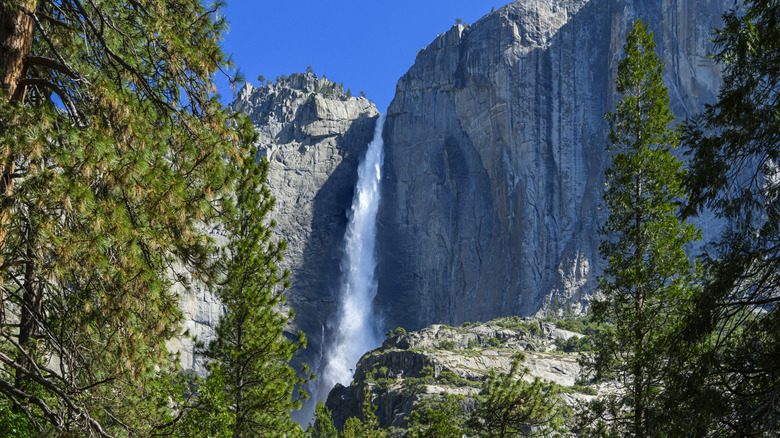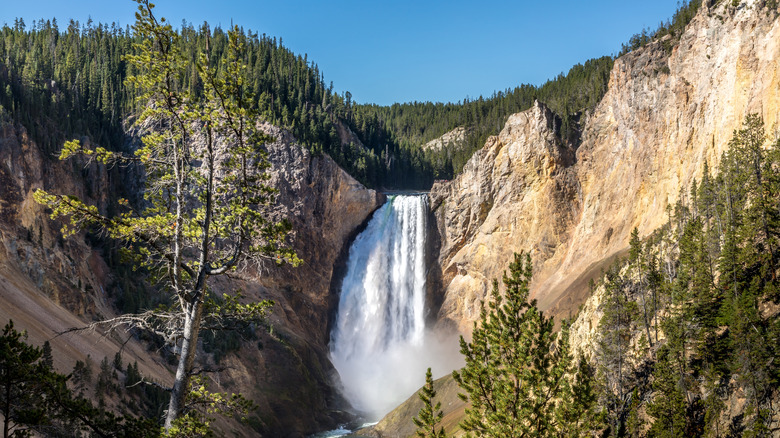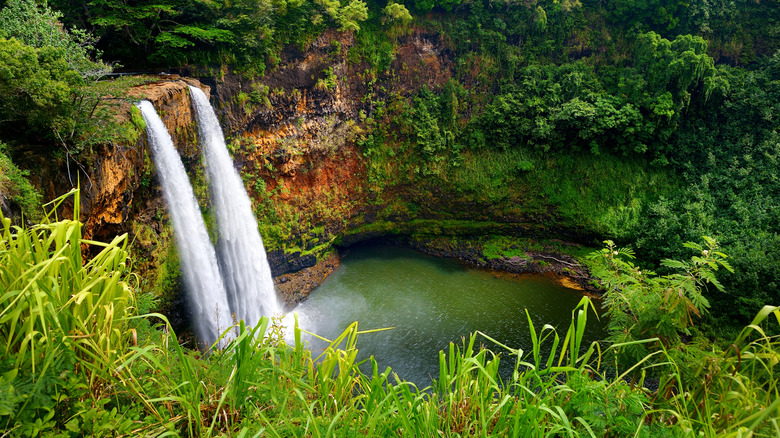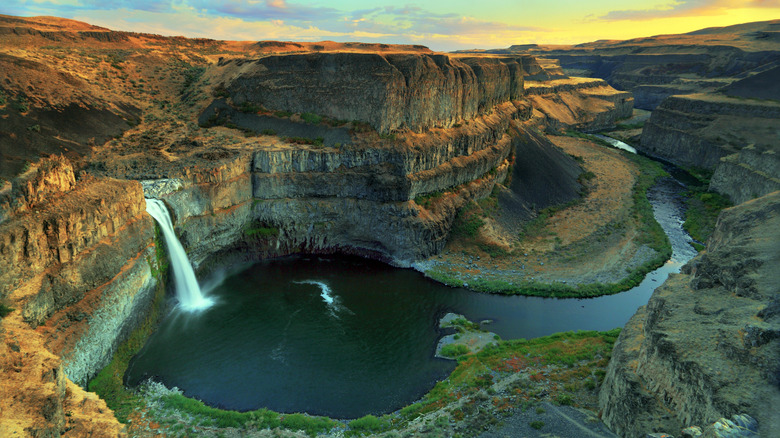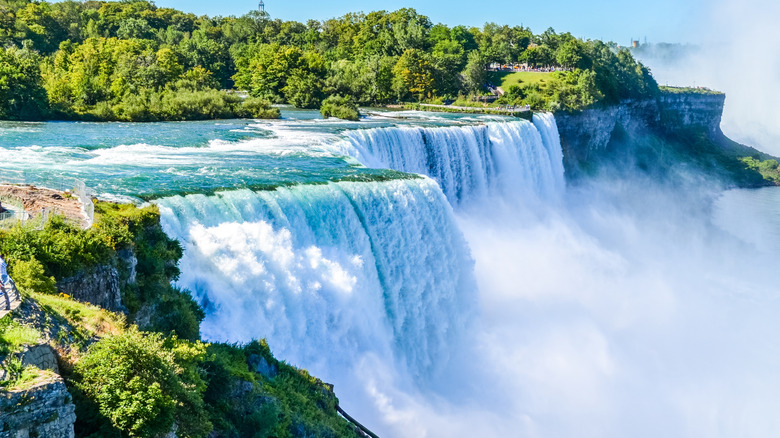The Best Places In America To See Waterfalls (That Aren't Niagara Falls), According To Visitors
Natural wonder enthusiasts can find an astounding 17,000 waterfalls to explore throughout the U.S. Among these is the iconic Niagara Falls, the crown jewel of countless travel bucket lists that straddles the U.S. and Canada (you can even soar over it in an immersive theater experience). Hailed for its staggering beauty and enormous gush, Niagara pumps out 6 million cubic feet of water every minute. It's the fastest-moving waterfall in the world, reaching speeds up to 68 miles per hour.
But Niagara Falls isn't the only place in the country where you can marvel at such grand displays. In fact, it might not even be one of the country's best waterfall spots, considering that many reviews mention the area is full of tourist traps. According to visitor testimonies online, the best places in America to see waterfalls showcase stunning natural beauty without that tourist-trap feel. From a vast collection of national park cascades and far-flung island flumes, we've narrowed down the nation's top contenders to bring you a list of the five most mesmerizing waterfalls in the U.S., including Washington's Palouse Falls and Shoshone Falls in Idaho.
Most of these gems were birthed during the Ice Age, when glacial melting and erosion carved majestic canyons into the earth. The outlier in this roundup, Wailua Falls, was formed in part by lava oozing its way through a tropical rainforest. Regardless of their origin stories, these once-in-a-lifetime vacation destinations are sure to amaze any waterfall enthusiast.
Shoshone Falls, Idaho
Shoshone Falls, located in Twin Falls, Idaho, has long been hailed as "the Niagara of the West." Clocking in at 212 feet tall and 900 feet wide, it actually tops Niagara Falls in terms of height and ranks among the largest waterfalls in America. This thundering powerhouse also stands out for its sheer volume, pumping up to 32,000 cubic feet of water per second from the Snake River over a basalt gorge that empties into the Columbia River. Considering these stats, it's no wonder people have flocked to this impressive attraction since the 1800s, when it first began luring westward travelers from their journey along the historic Oregon Trail.
You can find this astounding sight at Shoshone Falls Park. While open year-round, the park is best visited in spring, when melting snowfall enlivens the cascades. During this season, you can also catch Shoshone Falls After Dark, an event that brings festival vibes, concerts, light shows, and food vendors to the area. The flow lightens up during summer and fall, as water from the Snake River is diverted for irrigation, but activities like hiking, picnicking, and boating against the canyon's pristine backdrop still make for an exceptional outing. In the winter, massive icicles dangle from the rocks, which, according to past visitors, guarantees a unique experience.
As one Tripadvisor user wrote in their 5-star review of the location, "The expansive views were breathtaking and there was cool frozen ice." Just remember, if you plan to stop by this Idaho natural wonder during winter, check that road conditions are safe before attempting the drive.
Yosemite Falls, California
Yosemite Falls has earned its place among the world's most ethereal waterfalls. Ensconced inside California's sprawling Yosemite National Park, this three-tiered cascade flows 2,425 feet from the upper to the lower section and ranks as the tallest waterfall in North America.
The Upper Falls are the largest part of this landmark. If you hike to platforms above or at the base of the Upper Falls, you'll be rewarded with jaw-dropping views of a towering 1,430-foot cascade that makes up more than half of Yosemite Falls' total height. The Lower Falls plunge 320 feet, and you can easily view them from a nearby platform accessible by a mild 1-mile hiking loop. The middle cascades, a handful of falls that drop 675 feet into a deep, craggy canyon, are fairly treacherous to reach and mostly obscured from view.
The best time to visit Yosemite Falls is in the spring, when the cascades are at their fullest. During late summer and fall, the waters tend to run dry. One special time to marvel at this force of nature is during a kaleidoscopic occurrence known as a moonbow, which you can catch from April through June. This colorful phenomena occurs when light from the full moon hits the mist of the lower falls to form a dazzling rainbow.
Lower Falls, Wyoming
Up to 6,000 gallons of water per second rush over the Rocky Mountains at Lower Falls, the largest waterfall in Wyoming's legendary Yellowstone National Park. Here, the water drops 308 feet, but combined with Yellowstone's majestic Upper Falls, the plunge encompasses a total of 600 feet. While Lower Falls is the more accessible cascade of the two, one adventurer on Tripadvisor wrote that visitors shouldn't miss the trek to Upper Falls. "Though you can view the Lower Yellowstone River Falls from several outlook points," they explained, "it is definitely worth the hike down to the top of the Falls. Such force and magnitude of water rushing over the falls."
The second most-photographed spot in Yellowstone after Old Faithful, the Lower Falls boast four separate viewing platforms that give visitors ample opportunity to wrap their heads around one of the country's most glorious natural wonders. These falls also mark the head of the Grand Canyon, where you can drink in the view from Artist's Point. Meanwhile, on the east side of the park, spots like Inspiration Point, Lookout Point, and Grandview Point provide plenty of outstanding overlooks.
Plan your visit to Lower Falls between May and July, when melting mountain snow fuels a spectacular torrent of water against a vibrant springtime backdrop of wildflowers. The cascades weaken deeper into summer and autumn, but cooler temperatures and fall foliage still make harvest season a great time to visit. If you're planning a larger vacation itinerary, consider checking out the best times of the year to visit Yellowstone National Park.
Wailua Falls, Hawaii
Anyone who remembers the '70s and '80s TV show "Fantasy Island" will instantly recognize Hawaii's glorious Wailua Falls from the opening credits. This duo of deluges (not to be confused with the attraction of the same name found on our list of Maui's most magical waterfalls) resides on the island of Kauai. Wailua Falls spills over red cliffs and into a pretty pool encircled by a decadent tropical rainforest. Arrive at the right time, and you'll discover this 80-foot flume dazzling onlookers with some breathtaking optical illusions. Morning visits yield a heavenly rainbow fanning out across the waterfall's basin, while outings following heavy rains see the dual cascade appear as one single flow.
One thing visitors love about Wailua Falls is its accessibility. "Great view of the falls, for a quick stop near Lihue," one Tripadvisor review noted. "We were able to get off the highway view the falls and keep en route under 30 minutes." Situated inside stunning Wailua River State Park, the area features a well-maintained parking lot conveniently located next to a viewpoint perfect for admiring the dreamy falls. Such easy, trek-free viewing also makes Wailua Falls accessible for wheelchairs, strollers, and travelers with limited mobility.
The falls feed the winding Wailua River, where you can embark on a riverboat cruise to explore some of the Wailua River Valley's most scenic and historic destinations. Among these are the Wailua Complex of Heiaus, once an ancient political-religious center and now a National Historic Landmark. If you're determined to experience all of Kauai's best views and things to do, you should also follow the river to Fern Grotto, where vibrant emerald ferns crawl along 1 million-year-old walls of lava rock.
Palouse Falls, Washington
Stunning Palouse Falls spills from the mouth of a steep basalt gorge and sweeps water from the 13,000-year-old Palouse River down into the Snake River below. Lay eyes on this surreal scene, and it's easy to understand how Palouse Falls beat out more than 3,000 other cascades to become Washington's official state waterfall.
Steeped in Native American lore, the Palouse people originally named Palouse Falls "Aput Aput," which means "falling water." Ice Age floods are responsible for this natural wonder, but according to Native American legend, the waterfall was created by a mythical creature called Big Beaver. Hunted and speared by a relentless band of brothers, Big Beaver ripped away at the canyon walls whenever he was struck and left claw marks behind. All the gouging eventually opened up the canyon, allowing in the rushing water.
Palouse Falls resides in Palouse Falls State Park Heritage Site, a 94-acre woodland where hiking, birdwatching, and marveling at the eponymous waterfall are the top activities. Located in southeastern Washington about an hour and a half south of Spokane, the 198-foot waterfall is a spring and summertime must. "The canyon opens up abruptly and it is impressive!" one Tripadvisor review raved. "We visited in April and loved it so much we returned in August." If you don't mind the chill, Palouse Falls is also a worthy wintertime destination. The whirling cascade freezes up, but flowing water is still visible beneath an icy layer of Snake River.
Methodology
To compile this list, we leaned on information provided by major travel publications and the National Park Service, as well as lists detailing the most prominent waterfalls in the country. From there, we narrowed down our selection of the five best waterfalls in America (excluding Niagara Falls, of course) by analyzing comments, information, and reviews provided by travelers in online forums like Reddit and Tripadvisor.
We specifically sought out waterfalls that aren't considered tourist traps, meaning they don't inflate pricing for entry tickets, parking fees, tourism fees, or items sold by on-site vendors. We also considered whether or not each waterfall was worth traveling to visit, accounting for factors like exceptional natural beauty, unique or significant cultural value, and placement inside a UNESCO-recognized U.S. National Park.
